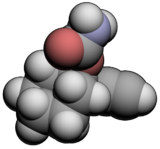Chemistry:Hexapropymate
From HandWiki
Revision as of 03:40, 6 February 2024 by imported>StanislovAI (link)
(diff) ← Older revision | Latest revision (diff) | Newer revision → (diff)
Short description: Chemical compound
 | |
 | |
| Clinical data | |
|---|---|
| ATC code | |
| Identifiers | |
| |
| CAS Number |
|
| PubChem CID | |
| ChemSpider |
|
| UNII | |
| ChEMBL | |
| Chemical and physical data | |
| Formula | C10H15NO2 |
| Molar mass | 181.235 g·mol−1 |
| 3D model (JSmol) | |
| |
| |
| | |
Hexapropymate is a hypnotic/sedative. It has effects similar to those of barbiturates and was used in the 1970s-1980s in the treatment of insomnia before being replaced with newer drugs with improved safety profiles.[1]
References
- ↑ "Hexapropymate self-poisoning causes severe and long-lasting clinical symptoms". Medical Toxicology and Adverse Drug Experience 4 (4): 295–301. 1989. doi:10.1007/bf03259914. PMID 2770531.
| Alcohols | |
|---|---|
| Barbiturates |
|
| Benzodiazepines |
|
| Carbamates | |
| Flavonoids | |
| Imidazoles | |
| Kava constituents | |
| Monoureides | |
| Neuroactive steroids |
|
| Nonbenzodiazepines | |
| Phenols | |
| Piperidinediones | |
| Pyrazolopyridines | |
| Quinazolinones | |
| Volatiles/gases |
|
| Others/unsorted |
|
 | 0.00      (0 votes) (0 votes) |
